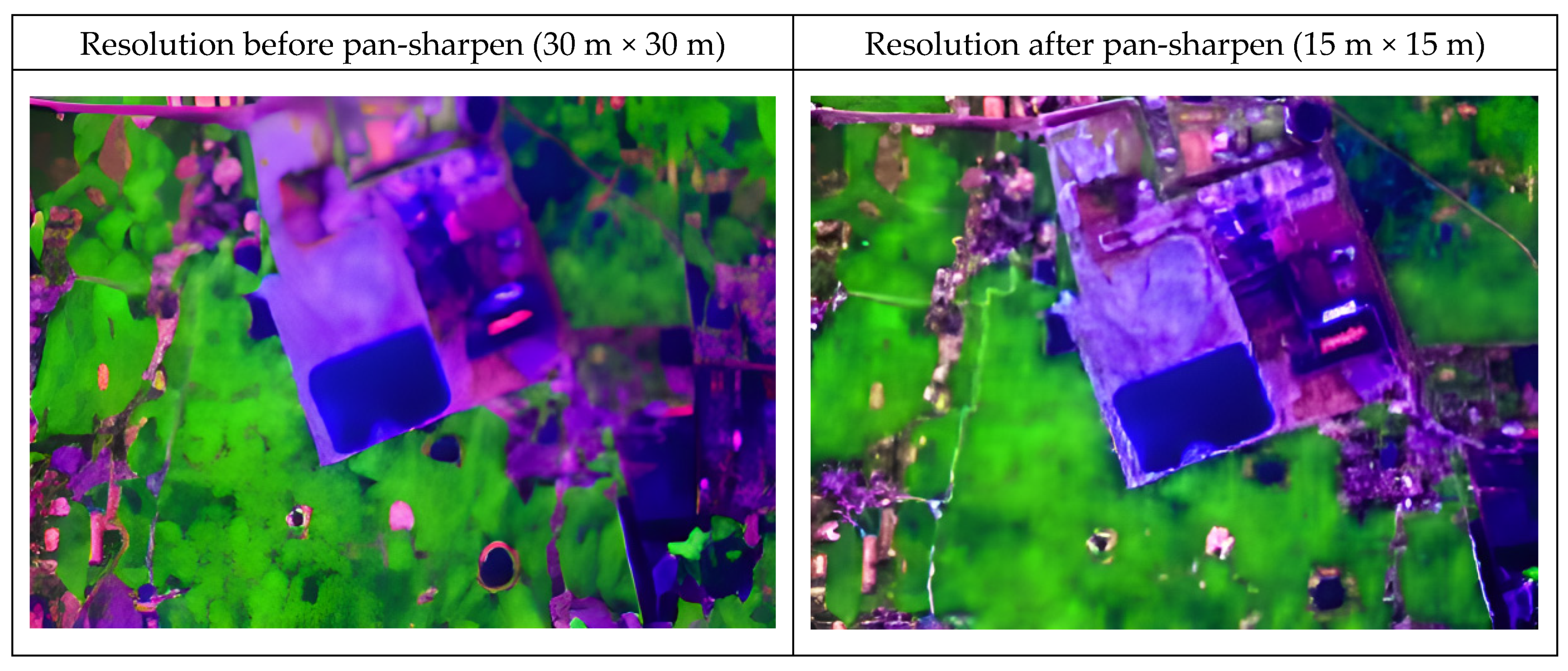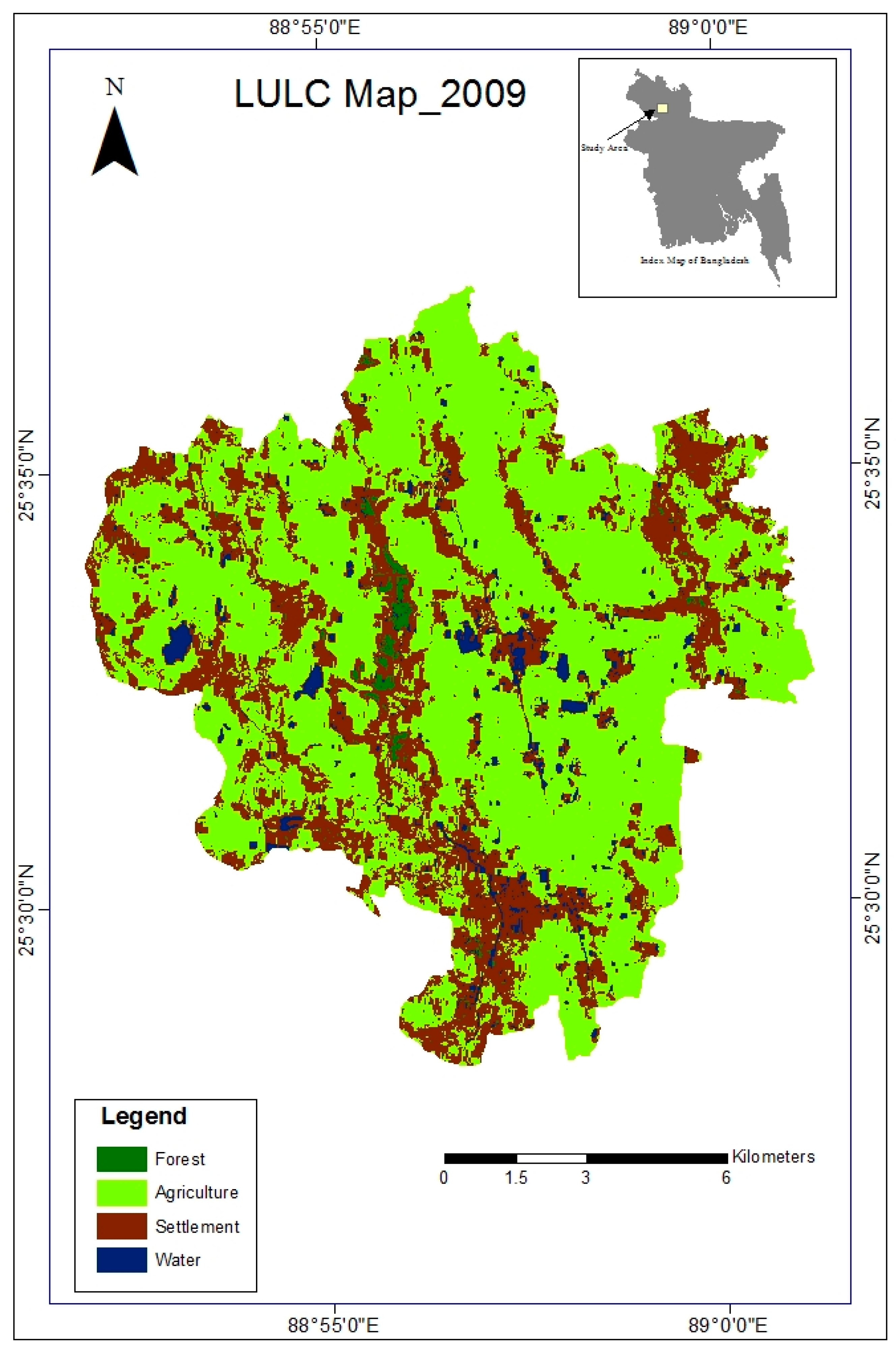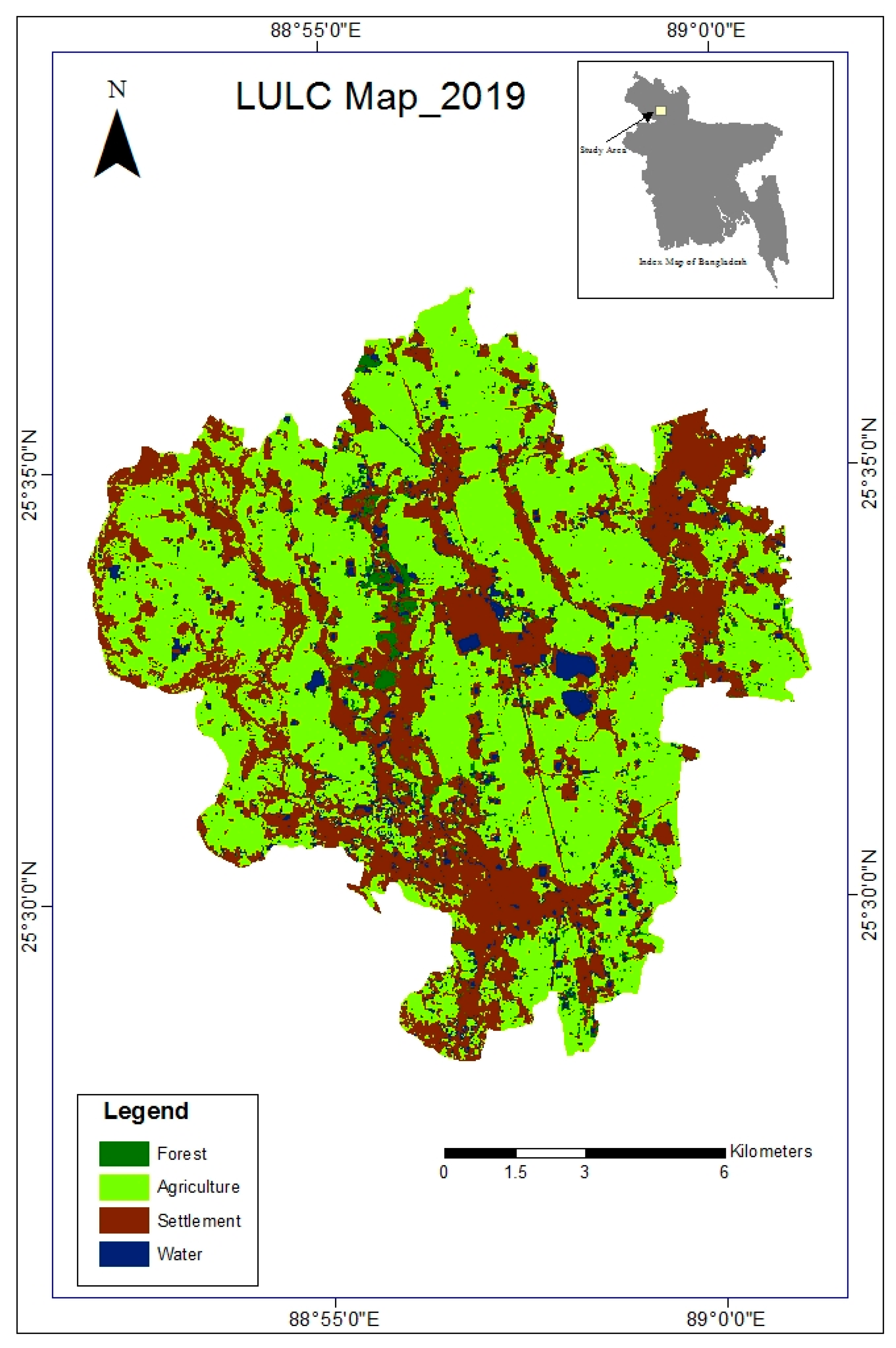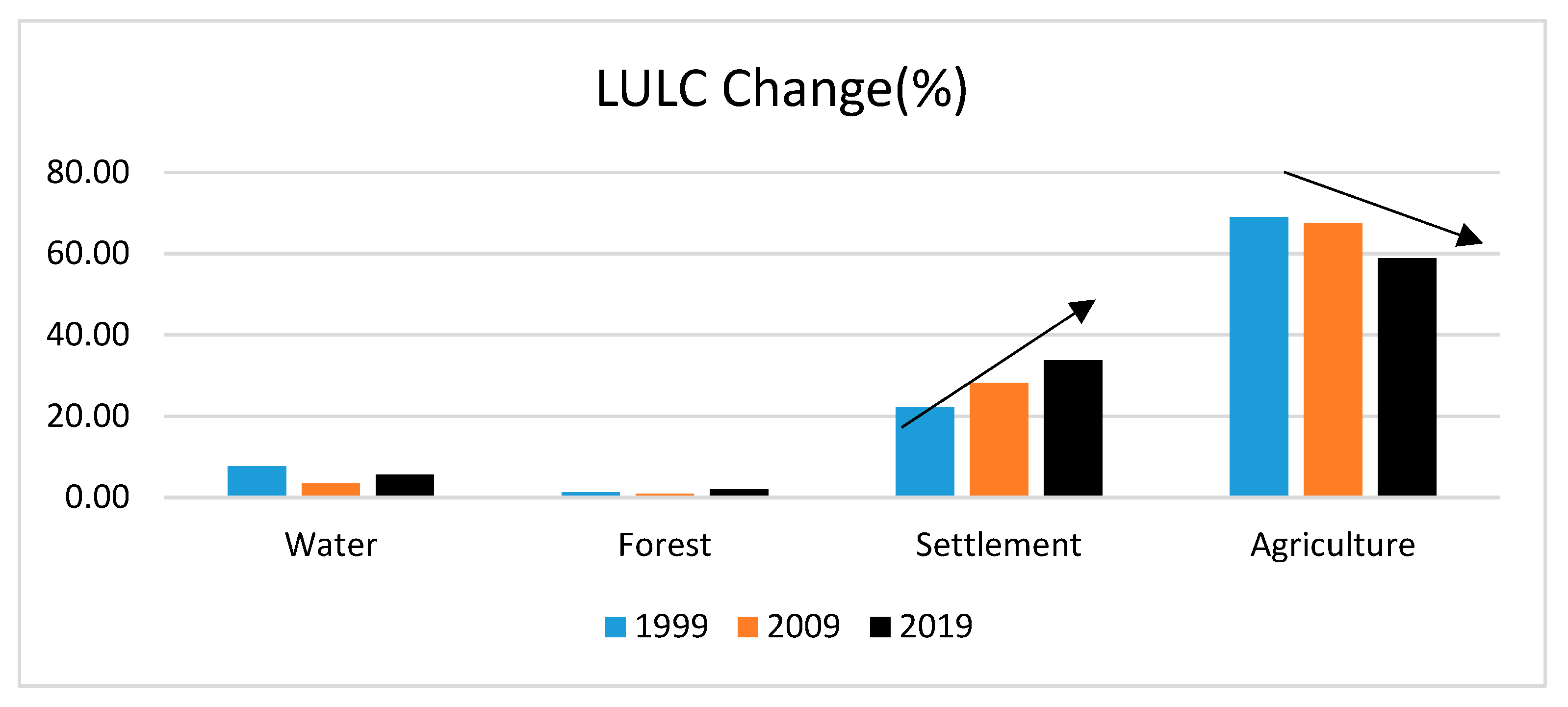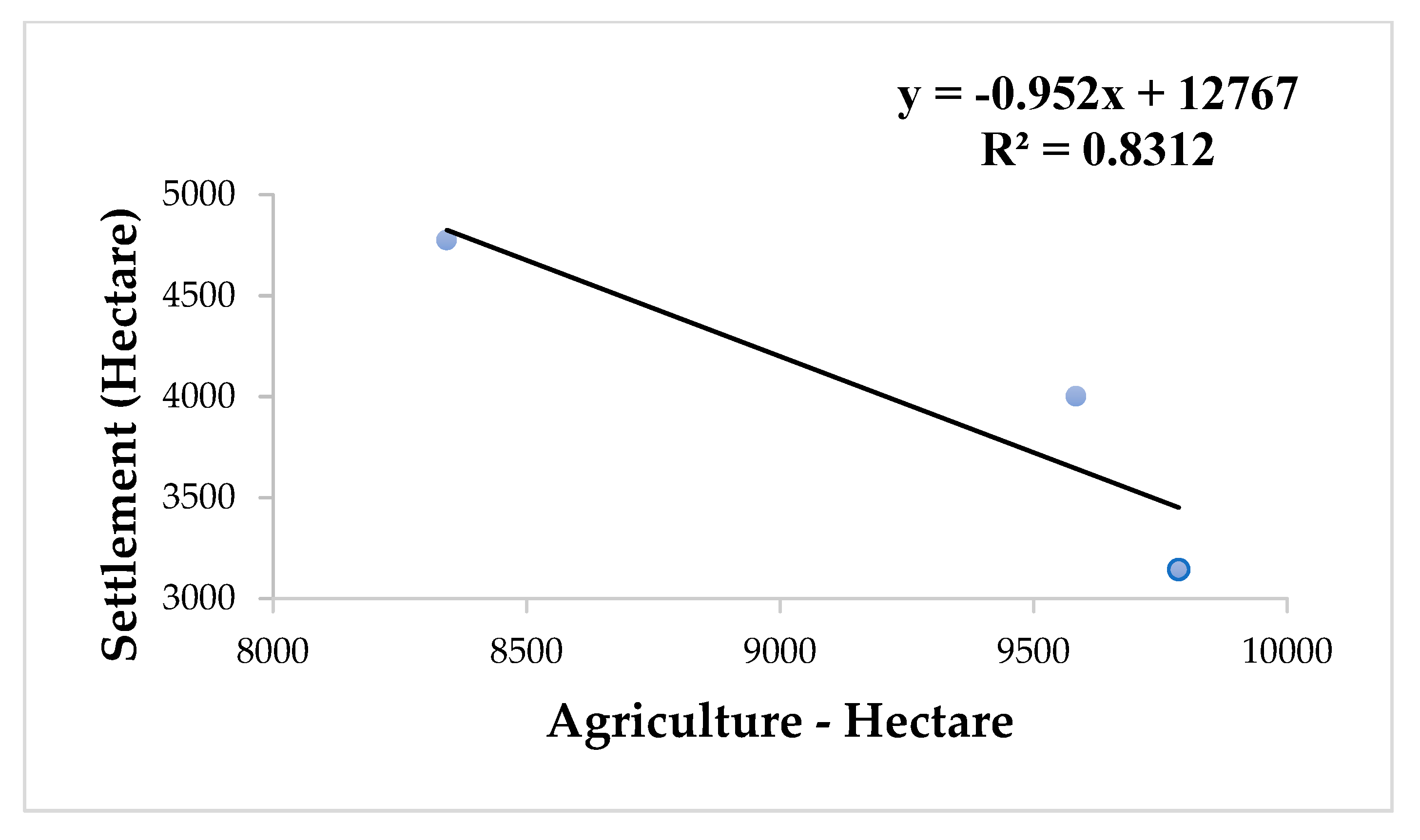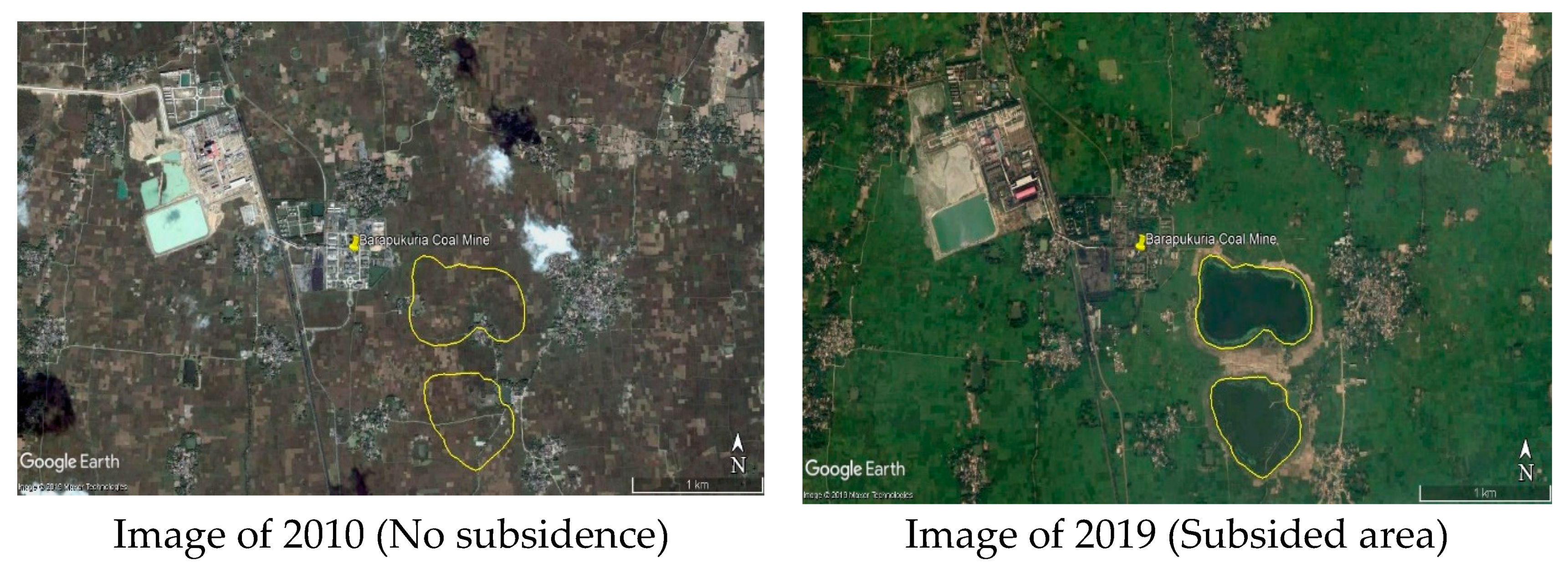1. Introduction
Despite different meanings, land cover and land use (LULC) changes are frequently applied in the same context [
1]. Land cover describes the natural characteristics of the earth’s surface, i.e., the dissemination of vegetation, water, soil and other elements of the land [
2]. On the contrary, land use considers the human aspect of land use, emphasising the economic aspects [
2]. Physical and socio-economic factors are the primary determinants influencing land use and land cover in an area. The changes in land cover/land use, mainly due to human intervention, play a vital role in comprehensively changing the atmosphere [
3]. Geographical Information System (GIS) and remote sensing techniques have provided a comprehensive and fruitful method for land use and land cover mapping in an area, i.e., agricultural, built-up, and other forms [
4]. Remote sensing data made it easy to analyse land use and land cover changes with reduced costs, lesser time, and better accuracy [
5]. In fact, LULC mapping is one of the robust remote sensing applications [
6]. In Ghana, remote sensing and geographical information system techniques were deployed to assess mine-related areas’ land use and land cover dynamics [
7]. Landsat satellite imageries of three different periods, i.e., 1991, 2000, and 2014 were used to quantify land use and land cover changes in the area.
Image differences showed a positive correlation with land use and land cover changes. The study revealed the declining vegetation trend and the significance of using satellite imagery. The effect of coal mining on LULC changes was analysed for a period of 24 years, i.e., from the year 1990 to 2014 in the Godavari coalfield, India [
8]. Research related to LULC change detection was conducted in the Dhanbad district of India [
9]. The researchers utilised Landsat satellite images for 1997, 2009, and 2017 to retrieve LULC data of the study area using the supervised classification maximum likelihood technique. Eleven classes were devised based on satellite image interpretation. Several works relating to land use and land cover changes have been completed in Bangladesh. The works address different issues, such as watershed, urbanisation and so on. An initiative was taken to map the urbanisation of Dhaka megacity (1990 to 2006) with multi-sensor data [
10]. Researchers assigned a Support Vector Machine (SVM) classifier and used a post-classification comparison to disclose spatio-temporal urban land-use and land-cover change patterns. Another work monitored and detected the land use and land cover change in Dhaka, Bangladesh, for 1960–2005 using topographic maps, multi-temporal remote sensing data, and the maximum likelihood supervised classification technique [
11]. The study illustrated the expansion of Dhaka city, the capital of Bangladesh, over the time frame. During this time gap, urban area rose by 15,924 hectares, while agricultural land reduced by 7214 hectares. Another approach was devised to quantify the land use land cover changes in greater Dhaka, Bangladesh, by applying remote sensing techniques on Landsat images and processing population and economic data [
12]. Researchers materialised the supervised classification principle along with the post-classification change detection model in GIS. They demonstrated that urban areas expanded while water bodies, agricultural land, and vegetation had a reducing trend.
Population growth and economic development are the forces for urban expansion. Moreover, Ahmed et al. [
13] modelled Urban Land Cover Growth Dynamics Using Multi-Temporal Satellite Images in Dhaka, Bangladesh. LULC changes concerning Gazipur Sadar Upazila in Bangladesh were analysed during the 1973–2017 period using Landsat imagery and the maximum likelihood supervised classification algorithm [
14]. They stated that urban areas had expanded while vegetation reduced during the same period. Sundarbans, the largest mangrove forest globally, had been assessed for forest cover from 1989 to 2000 using Landsat Thematic Mapper (TM) satellite imagery [
15]. Three image processing modules, including Normalised Differential Vegetation Index (NDVI), maximum likelihood classification scheme, and sub-pixel classification, had been applied in the scheme. Research on forest land changes concerning the Chunati Wildlife Sanctuary (CSW) from 2005 to 2015 was conducted using Landsat images and a supervised maximum likelihood classification algorithm [
16]. A study of Tangoar haor, a Ramsar site of Bangladesh, revealed that approximately 40% of land cover from the studied area had been converted into other types during the last 30 years (1980–2010) [
17]. It was achieved using GIS, remote sensing techniques, and the maximum likelihood supervised classification method. The study clearly stated that forest and highland disappearance increased while settlements increased. Halda watershed, the most potent fish breeding zone in Bangladesh, was analysed for the last 40 years (1978–2017) and classified into five categories: water, vegetation, agriculture, bare soil and settlements [
18]. Their research indicated a significant shift in water and vegetation to agricultural land, bare soil, and settlement areas. Arifeen et al. [
19] recently researched land use and land cover change detection, urban expansion, and determining factors in Gazipur, Bangladesh. They found higher urbanisation due to population and economic growth, location, and accessibility. Rohingya population played a critical role in changing the environmental setting of Cox’s Bazar, Bangladesh [
20]. The study simulated outcomes showing vegetation reduction habitation growth by 2030.
In northern China, coal mining-related subsidence is a prime geohazard [
21]. Coal mine subsidence and deformation mapping were conducted using Differential SAR (Synthetic Aperture Radar) Interferometry. Improved radar interferometry and persistent scatter interferometry was used with the small baseline subset methodology to demarcate and quantify the surface distortion of an underground coalfield in Springfield, Illinois, USA [
22]. From 1992 to 2000, the highest subsidence rate was −4.1 mm/year, and during 2007–2011, it was −35.9 mm/year.
Bangladesh is a developing nation having a rapid growth rate. According to the World Bank, Bangladesh’s Gross Domestic Product (GDP) growth rate was 7.9% in 2018 [
23]. Fulfilling the development goals in Bangladesh leads to higher energy needs, and coal is an important energy source to fulfil this requirement. The Barapukuria coal mine is the only operational coal mine in Bangladesh. Hence, the impact of mining-related LULC changes was assessed to reduce the adverse effect on the atmosphere, policy-making, and actual land administration [
8,
24,
25,
26]. Satellite data is critical and significant for verifying changes in land use and land cover [
8,
27]. There are some research works related to land use and land cover in Bangladesh. These works employed GIS and Remote sensing techniques; however, there is no research concerning mines. This work is the first attempt to analyse land use and land cover changes in a mining zone in Bangladesh.
The area has witnessed changes due to anthropogenic aspects related to mining. In the future, this area might be severely impacted in the LULC context, and this area’s natural aspects could be impacted. Moreover, the knowledge obtained by studying this coal mine will educate policymakers and mine developers about different environmental issues and the harmful consequences of mining. This knowledge could be used while preparing policies for developing other coal mines in Bangladesh. Therefore, the primary goal of this venture is to observe LULC changes in a specific time frame and analyse the pattern of changes by incorporating GIS and remote sensing algorithms. This data will help determine how mining adversely affects nature and impacts efforts towards Sustainable Development Goal (SDG) 15 (Life on Land).
4. Results
This section comprises subheadings. It provides a concise and precise description of the experimental results, interpretation, and conclusions.
4.1. Land Use and Land Cover Status
4.1.1. LULC Status of the Study Area, 1999
In 1999, the study area was dominantly covered by agricultural land (69%). As Bangladesh is an agricultural country, most lands were agricultural, followed by settlements (22%), water bodies (8%), and forests (1%). (
Figure 3 and
Table 3).
4.1.2. LULC Status of the Study Area, 2009
In 2009, the study area was dominantly covered by agricultural land (68%). The total agricultural land decreased approximately 1.5% but occupied the maximum area. Settlements increased to 28% in that year, and water bodies and forest area decreased to 3% and 1%, respectively (
Figure 4 and
Table 3).
4.1.3. LULC Status of the Study Area, 2019
In 2019, the reducing agriculture trend continued, and agricultural land was approximately 59%, while settlements expanded to about 34% of the total area. Water bodies and forest areas increased slightly to 5% and 2% (
Figure 5 and
Table 3).
Table 3.
Type and year wise LULC distribution of the area (Hectares).
Table 3.
Type and year wise LULC distribution of the area (Hectares).
| LULC | Area 1999 | Area 2009 | Area 2019 |
|---|
| Hectare | % | Hectare | % | Hectare | % |
|---|
| Water | 1079.753 | 7.609414 | 480.195 | 3.384111 | 788.265 | 5.555194 |
| Forest | 179.64 | 1.265989 | 123.975 | 0.873698 | 282.555 | 1.991269 |
| Settlement | 3143.903 | 22.15624 | 4000.838 | 28.19538 | 4775.243 | 33.6529 |
| Agriculture | 9786.398 | 68.96836 | 9584.685 | 67.54681 | 8343.63 | 58.80064 |
| Grand Total | 14,189.69 | 100 | 14,189.69 | 100 | 14,189.69 | 100 |
Table 4 summarises the changes corresponding to years 1999, 2009, and 2019 concerning area (Hectares), percentages (%), and annual average (Hectares) considering the four LULC classes.
4.2. Statistical Analysis
Percentage-based land cover distribution for different years is depicted in
Figure 6.
The figure depicts the increase in settlements (built-up area) and decreases in agricultural land. It also implies the conversion of agricultural lands into settlements. In 1999, agricultural land was approximately 69%, while settlements were around 22%. However, in 2019, settlements occupied about 34% of the area, and agricultural land was around 59%. Settlements expanded by more than 50% from their previous state (22% to 34%) during these 20 years. It resembles the case in Sikkim, India, where the built-up area rose, and cultivation land shrunk [
36]. The built-up area increased 2.13% (5.41 km
2), and agricultural land dropped 2.83% (7.22 km
2).
Figure 7 and
Figure 8 illustrate the relative changes in area (hectares) and percentage of the land-use class types. Settlements (Built-up/Urban) increased in the entire analysis period, while other land classes demonstrated mixed trends; however, agricultural land decreased rapidly.
LULC is strongly correlated with time (
Figure 9).
With time, it is noted that the reduction or enhancement of land class type is noticeable, which is crucial to evaluate each land type’s internal connection.
The prominent land use classes are correlated and have decreasing or increasing trends (
Figure 10). The following statistical figure demonstrates that rising settlements correlate strongly (negatively) with the downward movement in croplands (R
2 = 0.8312).
4.3. Changes by Land Type
The changes in the study area during the observation period is categorised into two types: immediate change and ultimate change. Immediate change denotes the changes every ten years, while ultimate change indicates the overall change during the study period.
4.3.1. Immediate Change
(I) Changes between 1999 to 2009: During 1999–2009, except settlements, all LULC types, including agriculture, forest, and water, had a declining trend. Six hundred hectares of water body area was lost (
Figure 11 and
Table 5). In 1999, water bodies totalled around 1080 hectares. In 2009, water bodies lost area to agriculture and settlements. Forestry and agriculture also lost area during this period. On the contrary, settlements increased to 857 hectares, gaining 27.26% of land area, equalling 86 hectares per year.
(II) Changes between 2009 to 2019:
During 2009–2019, except agriculture, every type of LULC, including settlements, forests, and water bodies, had an upward trend. Settlements gained 774 hectares (
Figure 12 and
Table 6). In 2009, the area of all settlements was around 4000 hectares. In 2019, settlements borrowed land from agriculture, water, and forest use. Forestry and water also lost area during this period. There was a significant loss in agricultural area because most agricultural land was used for settlements.
4.3.2. Ultimate Change
Changes between 1999–2019:
During 1999–2009, in the broader sense, settlements and forests gained land while agriculture and water bodies were lost. Settlements increased by 1600 hectares during the mentioned time frame, and forests gained 100 hectares (
Figure 13 and
Table 7). On the contrary, agriculture reduced by 1443 hectares, and water bodies declined tentatively by 300 hectares. Overall, settlements increased by 52%, and forests increased by 57% from 1999 to 2019. Agricultural land reduced by 15%, and water bodies decreased by 27%.
4.4. Accuracy Assessment
Validation of the four land classes in terms of overall accuracy and kappa coefficients was executed for 1999, 2009 and 2019. One thousand randomly identified points were created on the Arc map for land use and land cover maps of 1999, 2009 and 2019.
The first 20 points of each LULC class for 2019, 2009 and 1999 were exported to Google Earth Pro for accuracy assessment. The prepared LULC classes were validated using Google Earth (
Table 8,
Table 9 and
Table 10).
For 2019, producer accuracy, user accuracy, overall accuracy and kappa coefficient values were the four metrics computed for assessment. Producer accuracy ranged between 52.63 and 100; user accuracy ranged between 60 and 100; overall accuracy was 73.75%, and kappa coefficient was 0.65.
For 2009, producer accuracy ranged between 56.67 and 100, while user accuracy ranged between 50 to 90. Overall accuracy was 72.50%, and the kappa coefficient was 0.63.
For 1999, Google Earth did not have higher resolution images to indicate precise positions concerning specific land classes. As research accuracy assessment is based solely on images provided by Google Earth, it was infeasible to validate settlements data for 1999. However, expert knowledge and experience indicated that settlement (built-up) areas are established near roads and riversides; these areas have a sporadic tree presence. Hence, it can be inferred that settlements were validated correctly to some extent.
Moreover, during the dry period (November–March), seasonal channels dried, causing data mismatch—homestead trees were confused for forests. These happened for all periods (1999, 2009 and 2019). In 1999, producer accuracy ranged between 63.16 and 100; user accuracy ranged between 60 and 90. Overall accuracy and kappa coefficients were 75% and 0.67, respectively.
Overall accuracy exceeded 70%, and the kappa coefficient value was more than 0.60 for each work period.
5. Environment Impact
The conducted research is pertinent to the changes of LULC in the Barapukuria Coal Mine under the district of Dinajpur, Bangladesh. The research work was conducted incorporating GIS and remote sensing techniques and open-sourced Landsat imageries to reveal the surficial land type changes before and after the establishment of the coal field. The major increasing land class is settlement, while decreasing class is agricultural land.
The three maps (
Figure 3,
Figure 4 and
Figure 5) indicate a change in land cover distribution. It is an agro-based zone with settlements, forestry, and a few water bodies. Settlements are distributed everywhere in the study area, especially in the southern and north-eastern parts, such as the expansion of greater Dhaka [
37]. The urban region of Dhaka expanded towards the north, northwest, and southwest, and the present study area expanded to the southern part consisting of Phulbari Pourasava (An administrative unit, such as a municipality), a large business and residential zone in this region.
The area is increasing with the development of the Barapukuria Coal Mine and the adjacent power plant. The observations are similar to Shanghai, China, where the total urban area was approximately 255 km
2 in 1979; however, it grew to 1968 km
2 in 2009 [
38]. It is also opposite to Shanghai [
39], where the main driving resources to the development are human activities and socio-economic development, but the major infrastructure is the only reason for the change in the Barapukuria area.
Agricultural land is decreasing despite the area being an agricultural zone. The agricultural land is distributed and witnessing a reducing trend with new settlements and infrastructure, which is not the case for the Godavari coalfield in India. Agricultural land in this coalfield increased from 59.46% in 1990 to 62.22% in 2014 [
8]. Similar to Barapukuria, Amman [
40] experienced the reduction in vegetation area due to the increase in the built-up area. Amman lost 18.82 km
2 of vegetation, while Barapukuria dropped 1442.768 hectares of agricultural land. Forests occupy the central part of the region following a north–south trend, occupying minor parts on maps. In the near future, forest areas may be hampered by the advancement of different infrastructures and development works, such as Botswana [
41]. In the Gaborone dam catchment area, Botswana, the built-up area increased from 1984 to 2015 and shrubland and savanna decreased for different development activities. Water bodies are widely distributed throughout all three maps and cover small areas. There is a river named “Little Jamuna” in the mid-west. It runs from north to south and covers the area as an elongated strip. The river is almost dry in the dry season. Due to the mining-related development activities, water bodies are also in a reducing trend. The total loss of the area’s water body is about 291.488 hectares from 1999 to 2019, which shows analogous trend of water body losing in South-eastern Tanzania [
42].

